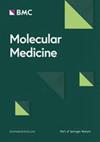USP1 对炎性小体成分的多重调控作用促进甲状腺滤泡细胞的脓毒症并导致桥本氏甲状腺炎的恶化
IF 6
2区 医学
Q1 BIOCHEMISTRY & MOLECULAR BIOLOGY
引用次数: 0
摘要
炎症性疾病通常是由病原体相关分子模式(PAMPs)和内源性损伤相关分子模式(DAMPs)触发的炎性体活化引发的,这些炎性体介导了热变态反应。虽然在桥本氏甲状腺炎(HT)患者中观察到了甲状腺滤泡细胞(TFCs)因炎性酶体异常触发而导致的热蛋白沉积,但其基本机制仍然不为人知。鉴于蛋白质泛素化和去泛素化在炎症性疾病中的广泛参与,我们旨在研究去泛素化酶如何调控甲状腺滤泡细胞的热解和HT的发病机制。我们的研究特别调查了泛素特异性肽酶1(USP1)(一种去泛素化酶(DUB))在调节炎性体成分NLRP3和AIM2中的作用,而NLRP3和AIM2在脓毒症中至关重要。我们进行了一系列实验,以阐明 USP1 在促进与炎症小体相关的热蛋白沉积和 HT 进展中的功能。这些实验采用的技术包括敲除或抑制 USP1,测量包括 caspase-1、caspase-1 p20 和 GSDMD-N 在内的主要热蛋白沉积指标,以及使用小鼠模型检查 USP1 消减对 HT 的影响。此外,我们还探讨了 USP1 对 NLRP3 转录的影响及其与 p65 核运输的潜在相互作用。我们的研究结果提供了令人信服的证据,表明 USP1 通过去泛素化稳定 NLRP3 和 AIM2,在促进炎性体介导的热蛋白沉积和 HT 进展方面发挥了关键作用。此外,我们还发现 USP1 通过促进 p65 核转运来调节 NLRP3 的转录。敲除或抑制 USP1 会削弱细胞的嗜热性,caspase-1 p20 和 GSDMD-N 水平的降低证明了这一点,而 AIM2 的过表达则可恢复这一点。值得注意的是,在小鼠模型中消减 USP1 能明显改善 HT,这可能与使用热蛋白酶抑制剂 VX-765 和双硫仑治疗小鼠的效果相同。我们的研究强调了 USP1 在 HT 发病过程中对炎性体激活和 TFCs 中热蛋白沉积的调控机制。这些发现拓展了我们对 HT 的认识,并表明抑制 USP1 可能是治疗 HT 的一种潜在策略。本文章由计算机程序翻译,如有差异,请以英文原文为准。
Multi-regulatory potency of USP1 on inflammasome components promotes pyroptosis in thyroid follicular cells and contributes to the progression of Hashimoto's thyroiditis
Inflammatory diseases are often initiated by the activation of inflammasomes triggered by pathogen-associated molecular patterns (PAMPs) and endogenous damage-associated molecular patterns (DAMPs), which mediate pyroptosis. Although pyroptosis resulting from aberrant inflammasome triggering in thyroid follicular cells (TFCs) has been observed in Hashimoto's thyroiditis (HT) patients, the underlying mechanisms remain largely unknown. Given the extensive involvement of protein ubiquitination and deubiquitination in inflammatory diseases, we aimed to investigate how deubiquitinating enzymes regulate thyroid follicular cell pyroptosis and HT pathogenesis. Our study specifically investigated the role of Ubiquitin-specific peptidase 1 (USP1), a deubiquitinase (DUB), in regulating the inflammasome components NLRP3 and AIM2, which are crucial in pyroptosis. We conducted a series of experiments to elucidate the function of USP1 in promoting pyroptosis associated with inflammasomes and the progression of HT. These experiments involved techniques such as USP1 knockdown or inhibition, measurement of key pyroptosis indicators including caspase-1, caspase-1 p20, and GSDMD-N, and examination of the effects of USP1 abrogation on HT using a mouse model. Furthermore, we explored the impact of USP1 on NLRP3 transcription and its potential interaction with p65 nuclear transportation. Our findings provide compelling evidence indicating that USP1 plays a pivotal role in promoting inflammasome-mediated pyroptosis and HT progression by stabilizing NLRP3 and AIM2 through deubiquitination. Furthermore, we discovered that USP1 modulates the transcription of NLRP3 by facilitating p65 nuclear transportation. Knockdown or inhibition of USP1 resulted in weakened cell pyroptosis, as evidenced by reduced levels of caspase-1 p20 and GSDMD-N, which could be restored upon AIM2 overexpression. Remarkably, USP1 abrogation significantly ameliorated HT in the mice model, likely to that treating mice with pyroptosis inhibitors VX-765 and disulfiram. Our study highlights a regulatory mechanism of USP1 on inflammasome activation and pyroptosis in TFCs during HT pathogenesis. These findings expand our understanding of HT and suggest that inhibiting USP1 may be a potential treatment strategy for managing HT.
求助全文
通过发布文献求助,成功后即可免费获取论文全文。
去求助
来源期刊

Molecular Medicine
医学-生化与分子生物学
CiteScore
8.60
自引率
0.00%
发文量
137
审稿时长
1 months
期刊介绍:
Molecular Medicine is an open access journal that focuses on publishing recent findings related to disease pathogenesis at the molecular or physiological level. These insights can potentially contribute to the development of specific tools for disease diagnosis, treatment, or prevention. The journal considers manuscripts that present material pertinent to the genetic, molecular, or cellular underpinnings of critical physiological or disease processes. Submissions to Molecular Medicine are expected to elucidate the broader implications of the research findings for human disease and medicine in a manner that is accessible to a wide audience.
 求助内容:
求助内容: 应助结果提醒方式:
应助结果提醒方式:


